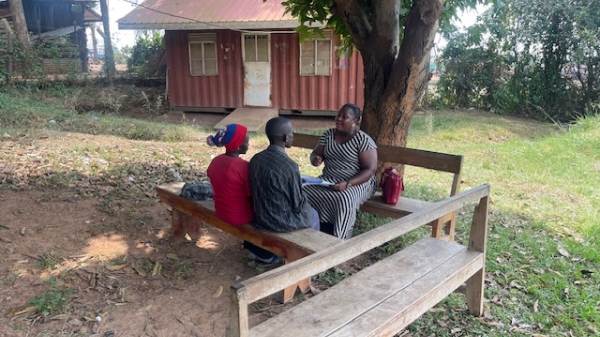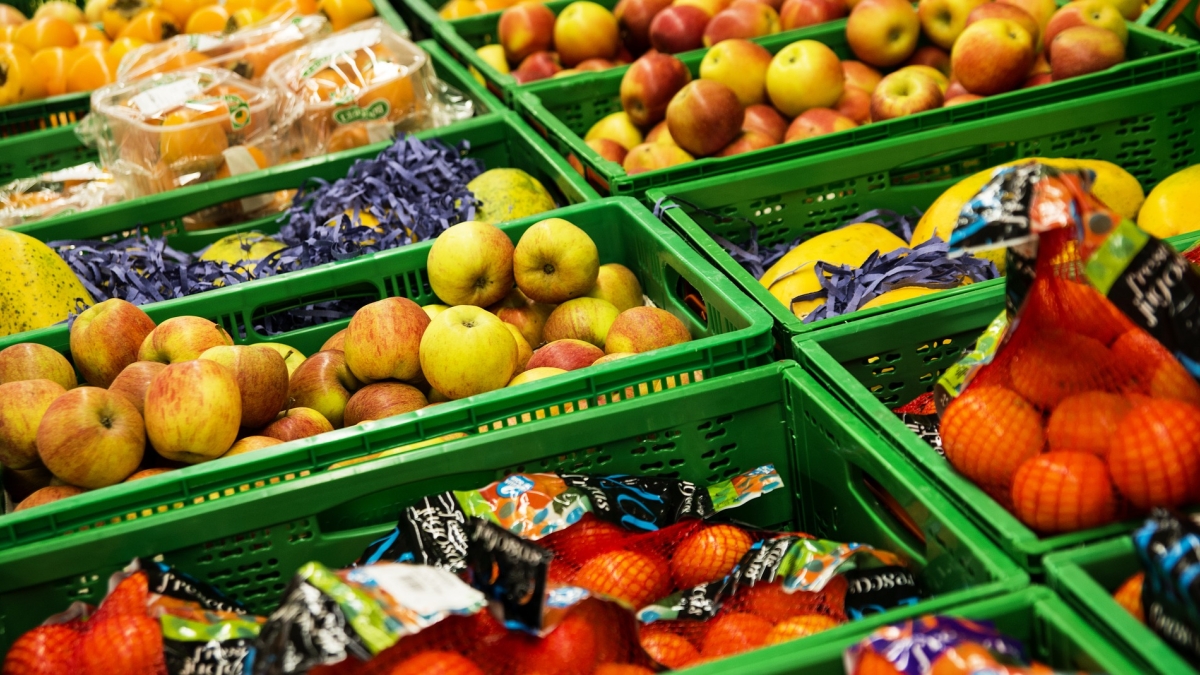As lunchtime nears, stomachs grumble and howl. That hangry sensation can claim control, overriding our ability to consider anything beyond satisfying the emptiness within. But beneath the surface, a wide variety of economic, social, cultural and ethical factors influence our decisions about what foods to pack in our lunchboxes or what snacks to grab from the store.
For Carola Grebitus, these thoughts are often at the forefront of her mind. Grebitus is an assistant professor of food industry management at Arizona State University, and her research through ASU’s Morrison School of Agribusiness includes the regular digestion of topics such as food labeling and consumer choice, and how both of these affect health and sustainability.
Before moving to the U.S. from Germany, Grebitus pursued a unique course of study called oecotrophologie, which combines food science, food economics and home economics. Given her appetite for cross-sector work, Grebitus has found ASU to be the perfect fit for her wide array of research interests.
“Being at ASU is so great because it is so interdisciplinary — it’s encouraged to work interdisciplinary and not just in a niche. For me that’s awesome,” she said.
Putting money where our mouths are
Grebitus’ research methods come from a field known as experimental economics, which uses experimental methods to explain economic ideas. Grebitus focuses on determining the actual willingness to pay for a more sustainable product.
Picture yourself striding down the aisle at your go-to grocery store. You see $3-per-pound locally grown, organic heirloom tomatoes on your left and $1-per-pound conventionally grown tomatoes in front of you. If asked on a survey, you might say you would purchase the sustainable $3-per-pound tomato. You care about the planet, after all. But experimental economics incentivizes consumers to answer truthfully by requiring an actual purchase. You might choose cheaper tomatoes when real money is at stake.
Sometimes, however, labeling can make consumers willing to pay more. In a study on beef purchases, Grebitus and her colleagues found that consumers who did not know the United States Department of Agriculture definition of “natural” would pay over a dollar more per pound for beef labeled as such. Those who knew the definition were not willing to pay a cent more, unless “natural” was combined with other labels such as “no growth hormones.”
To face the grocery aisles with confidence, Grebitus recommends understanding labels, in addition to considering the origin and seasonality of products.
Where we get our food matters
Origin labeling indicates the country in which many fresh foods (such as produce and some meats) were produced. Grebitus feels confident in the safety of her homeland’s products and in American food, too.
“When it’s from Germany I’m just assuming that they were audited and therefore it’s fine, and I would assume the same in the U.S. if it is grown here,” she said. “I have done a lot of research on trust. I trust U.S. farmers, I trust the Food and Drug Administration, I trust that everything is controlled.”
Yet she has found that her faith is not shared as widely amongst consumers. In a recent study, Grebitus and a doctoral student found that consumers trust farmers significantly more than food manufacturers and the government when it comes to food safety practices.
Of course, locally produced foods also travel less distance to reach your plate, which reduces pollution and carbon emissions from transporting them. Seasonality is another factor that plays into reducing these “food miles.” If you buy foods during seasons when they are not grown locally, they must be imported from somewhere with a different climate. For example, blackberries and blueberries are fruits of the summer — buying them in the spring would necessitate many additional miles of rubber on the road. (Check out this seasonal produce guide to make sustainable and in-season purchases.)

Urban farming can connect city dwellers with their food. A vacant lot in downtown Phoenix was transformed to a community space, including urban farming, as part the PHXRenews initiative.
Urban farming growing fast
One increasingly popular way to access locally grown, seasonal foods is through urban farming. Urban farmers grow crops and raise animals within and around cities. Grebitus is currently engaged in a cross-disciplinary project on urban farming, sponsored by the National Science Foundation and the USDAUrban farming research at ASU is supported by USDA-NIFA, Grant No. 2015-67003-23508 and NSF-MPS-DMS, Award No. 1419593. .
In the study, mathematicians, geographers and agricultural economists are developing a physics-based model to predict the impacts of increased urban agriculture. The final results of this study will reveal environmental, economic and socioeconomic impacts of developing urban agriculture in certain areas. Grebitus’ role specifically involves examining the social and economic aspects of urban farming to understand how it will affect neighborhoods and the environment.
“If you have agriculture in the city, you can lower the temperature of the urban heat island, but can it be successful from a business standpoint?” she said. “How can we get consumers to accept or even participate in urban agriculture, for example, by buying or growing their own food at urban farms?”
By supporting urban farming, consumers can get to know their local farmers or even become farmers themselves. This involvement can bring awareness to the high labor demands in the food production sector and expose the reality of choices and demands we make as consumers.
“Personally, I find it important that consumers or citizens aren’t so alienated when it comes to food production because the perception of farming and actual food growing is really different! So to get people to see how much labor goes into producing food would be really beneficial — and might alleviate some of their demands, many of which are often not aligned with the prices they are willing to pay,” Grebitus said.
The growing popularity of community gardens is a notable step in heightening awareness and encouraging consumer involvement. ASU’s Polytechnic campus boasts its very own Poly Gardens. Grebitus also admires the model of Agritopia, a neighborhood in Gilbert that practices traditional farming and has its own farm-to-table restaurant, Joe’s Farm Grill. On the menu, diners find appealing and healthy food choices — from a mouthwatering gouda garlic bacon burger stack to hand-breaded zucchini slices, all sourced directly from the surrounding farm.
Paying attention to what we eat and why
Grebitus also believes that nutrition education is a crucial step in promoting healthier diets. She suggests that we get people back in the kitchen by reinstating cooking lessons.
“It’s a big skill and I think so many people don’t really know how to cook anymore,” she said. “I feel like I learned so much from my parents and grandparents in terms of preparing meals. For me that is where nutrition education really would start.”
Although Grebitus’ research on sustainable eating and healthy food choice naturally encourages healthy eating habits, her guilty pleasure food will always be Nutella.
Laughing, she admitted, “I am not always as influenced by my research as I probably could be.”
And while we all have our one guilty pleasure (or more), Grebitus’ findings serve as food for thought to be digested as we consume our daily meals.
“I would hope that people are encouraged to eat healthier,” she said. “Also, that we have less food waste and more environmentally friendly behavior, and recognize how important the production sector is, the farming sector, how much work goes into it, and to be supportive of that.”
ASU offers a wide array of resources to support healthy eating and sustainable choices, including events and the Live Well blog. ASU also practices menu labeling to promote conscious meal choices and provides countless opportunities for staying active.
This article was written by Samantha Matta. Top photo courtesy pixabay.com
More Health and medicine

ASU researchers: Over-the-counter flu tests can 'revolutionize public health'
Influenza, more commonly known as the flu, causes 50,000-plus of deaths annually, but over-the-counter (OTC) tests for the disease are just beginning to emerge and are difficult to access.That’s a…

The beauty bias
Being one of the beautiful people has its benefits, but according to a recent study, living longer may not be one of them. On the other hand, those not blessed with the best facial features…

Pilot program to address HIV care, intimate partner violence in Uganda
Editor's note: This is the second in a five-part series about ASU faculty conducting summer research abroad. Read about carbon collection in the Namib Desert.Uganda has one of the highest rates of…
